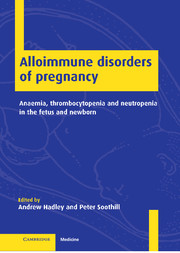 Alloimmune Disorders of Pregnancy
Alloimmune Disorders of Pregnancy Book contents
- Frontmatter
- Contents
- List of contributors
- Preface
- Foreword
- List of abbreviations
- 1 Pathophysiology of the alloimmune cytopenias
- 2 Blood group antibodies in haemolytic disease of the fetus and newborn
- 3 Basis and practice of screening for haemolytic disease of the fetus and newborn
- 4 Epidemiology and screening for alloimmune thrombocytopenia
- 5 Principles of antibody-mediated immune suppression and the prevention of maternal RhD alloimmunization
- 6 The clinical application of anti-D prophylaxis
- 7 Fetal genotyping
- 8 Laboratory assays to determine the severity of haemolytic disease of the fetus and newborn
- 9 Assessing the severity of haemolytic disease of the fetus and newborn: clinical aspects
- 10 Antenatal therapy for haemolytic disease of the fetus and newborn
- 11 Neonatal therapy for haemolytic disease of the newborn
- 12 The diagnosis of alloimmune thrombocytopenia
- 13 The immunological diagnosis of alloimmune neutropenia
- 14 Fetal and neonatal treatment of alloimmune thrombocytopenia
- Index
9 - Assessing the severity of haemolytic disease of the fetus and newborn: clinical aspects
Published online by Cambridge University Press: 26 October 2009
- Frontmatter
- Contents
- List of contributors
- Preface
- Foreword
- List of abbreviations
- 1 Pathophysiology of the alloimmune cytopenias
- 2 Blood group antibodies in haemolytic disease of the fetus and newborn
- 3 Basis and practice of screening for haemolytic disease of the fetus and newborn
- 4 Epidemiology and screening for alloimmune thrombocytopenia
- 5 Principles of antibody-mediated immune suppression and the prevention of maternal RhD alloimmunization
- 6 The clinical application of anti-D prophylaxis
- 7 Fetal genotyping
- 8 Laboratory assays to determine the severity of haemolytic disease of the fetus and newborn
- 9 Assessing the severity of haemolytic disease of the fetus and newborn: clinical aspects
- 10 Antenatal therapy for haemolytic disease of the fetus and newborn
- 11 Neonatal therapy for haemolytic disease of the newborn
- 12 The diagnosis of alloimmune thrombocytopenia
- 13 The immunological diagnosis of alloimmune neutropenia
- 14 Fetal and neonatal treatment of alloimmune thrombocytopenia
- Index
Summary
Introduction
With the established use of postnatal anti-D prophylaxis for D-negative women, together with its increasing use for routine antenatal prophylaxis, the incidence of sensitization to D has markedly fallen. This is reflected by the reduction in the overall number of cases of HDFN (Section 5.3.2). However, women with low anti-body levels or in their first sensitized pregnancies continue to be referred to tertiary fetal medicine units for specialized management. Considerable effort is, therefore, spent by fetal medicine specialists in monitoring the disease course, predicting its progression and deciding on the need and timing of intrauterine transfusions.
The most accurate test to assess the degree of fetal anaemia, and thus the need for transfusion, is direct fetal haemoglobin measurement by fetal blood sampling. However, cordocentesis can cause an increase in the antibody concentration and is associated with about a 1% fetal loss rate and so is not an appropriate first-line investigation. Fetal blood sampling is best reserved for cases where severe fetal anaemia is already suspected and so intrauterine transfusion is likely to follow. At amniocentesis, the needle is rarely passed transplacentally and, therefore, the risk of boosting the antibody level is less than with cordocentesis, although the procedure still has small but significant risks of causing miscarriage or preterm labour. In recent years, several noninvasive methods for the prediction of fetal anaemia have been assessed and these are now allowing the use of invasive testing to be deferred, usually until transfusion is necessary.
- Type
- Chapter
- Information
- Alloimmune Disorders of PregnancyAnaemia, Thrombocytopenia and Neutropenia in the Fetus and Newborn, pp. 153 - 172Publisher: Cambridge University PressPrint publication year: 2001
